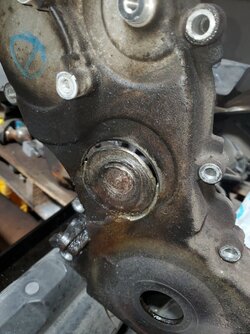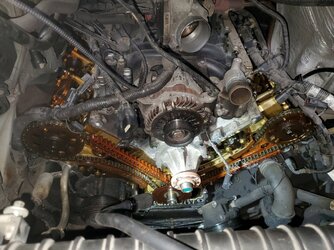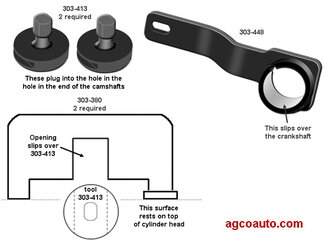racprops
Well-Known Member
- Joined
- January 25, 2019
- Messages
- 255
- Reaction score
- 98
- City, State
- Phoenix AZ
- Year, Model & Trim Level
- 2003 Explorer XLT 4.6 4WD
OK I need feedback on this problem: Timing chain repairs.
I have a 03 4.6 making some noise, the timing chains guilds are going. From the markings they were replaced at some point on the 03 timing chain replacement warrantee.
The Truck as 202,000 on it.
I am an old timer have driven a 2000 Mercury Grans Marques and a Crown Vic and are on a number of face book and web sites for them and these Explorers.
I have read over and over again and again that a lot of the time about 60 to 80% of the time all that is needed is the guilds.
That the sprockets and chains often do not suffer a lot of wear.
The nose was not so loud and I even considered it might be a idle pulley or some other belt driven problem so removed the fan and removed the serpentine belt to test it.
The noise was still there. My nose is mostly there at idle and get quite with higher RPMs.
I have a mechanic that wants to replace: Everything: Guilds, hydraulic pressure tensioners, chains, sprockets, oil pump, oil pressure sensor, cam sensor, perhaps a valve cover, or two, and Front seal and timing cover gaskets.
And he quotes $1600.00 to do all of that. And yet does not include a oil change of filter.
And this is the parts he wants to use, which he as telling me were made BY Ford, not for Ford.
href="https://www.carparts.com/details/Fo...t/Timing_Chain_Kit/2003/KIT1-021314-01-B.html">https://www.carparts.com/details/Fo.../2003/KIT1-021314-01-B.htmlstyle='font-family:"inherit","serif"'>
OK I am looking at the timing chain set above with oil pump.
First it is NOT saying anything about being made by Ford nor Motorcraft, (Which he claimed) Carpart is saying it is Replacement kit Manufacturer #KIT1-021314-01-B from Taiwan. (China adjacent) Which can mean they could buy their parts from China.
I called and waited some 30 minutes to check with Carparts.com and they told me where these came from. And that they have a one year mileage warrantee.
Which is no good as the labor is the killer.
This does not include the valve cover gaskets, front seal, timing cover gaskets, or the sensors like oil pressure and other stuff he talked bout.
He also talked about some hollow bolts that have an oil hole in them and can be broken when a torque wrench is used to tighten them.
Also I would think those special oiling bolts would be best replaced and not reused.
So engine builders and repairmen, which is right??
Rich
PS read the other threads on timing chains…no clear answer.
I have a 03 4.6 making some noise, the timing chains guilds are going. From the markings they were replaced at some point on the 03 timing chain replacement warrantee.
The Truck as 202,000 on it.
I am an old timer have driven a 2000 Mercury Grans Marques and a Crown Vic and are on a number of face book and web sites for them and these Explorers.
I have read over and over again and again that a lot of the time about 60 to 80% of the time all that is needed is the guilds.
That the sprockets and chains often do not suffer a lot of wear.
The nose was not so loud and I even considered it might be a idle pulley or some other belt driven problem so removed the fan and removed the serpentine belt to test it.
The noise was still there. My nose is mostly there at idle and get quite with higher RPMs.
I have a mechanic that wants to replace: Everything: Guilds, hydraulic pressure tensioners, chains, sprockets, oil pump, oil pressure sensor, cam sensor, perhaps a valve cover, or two, and Front seal and timing cover gaskets.
And he quotes $1600.00 to do all of that. And yet does not include a oil change of filter.
And this is the parts he wants to use, which he as telling me were made BY Ford, not for Ford.
href="https://www.carparts.com/details/Fo...t/Timing_Chain_Kit/2003/KIT1-021314-01-B.html">https://www.carparts.com/details/Fo.../2003/KIT1-021314-01-B.htmlstyle='font-family:"inherit","serif"'>
OK I am looking at the timing chain set above with oil pump.
First it is NOT saying anything about being made by Ford nor Motorcraft, (Which he claimed) Carpart is saying it is Replacement kit Manufacturer #KIT1-021314-01-B from Taiwan. (China adjacent) Which can mean they could buy their parts from China.
I called and waited some 30 minutes to check with Carparts.com and they told me where these came from. And that they have a one year mileage warrantee.
Which is no good as the labor is the killer.
This does not include the valve cover gaskets, front seal, timing cover gaskets, or the sensors like oil pressure and other stuff he talked bout.
He also talked about some hollow bolts that have an oil hole in them and can be broken when a torque wrench is used to tighten them.
Also I would think those special oiling bolts would be best replaced and not reused.
So engine builders and repairmen, which is right??
Rich
PS read the other threads on timing chains…no clear answer.













